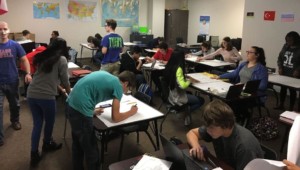Lessons from Leading a Career-Focused Early College Flex High School

Due to an unforeseen set of circumstances, I moved from board chair to Director/Principal for Career Path High three months into the first year of operation for this career focused flex high school.
Located at the Davis Applied Technology Center north of Salt Lake city, Career Path High (@careerpathhigh) is a career-focused early college flex high school. Students complete high school courses in a Learning Center and engage in hands-on career training courses in one of 30 fields on the college campus.
Being a high school principal is the hardest thing I’ve ever done, and I’m no stranger to a challenge. There were many issues that needed to be addressed. Add a Special Education population of 20% and a high percentage of credit deficit kids looking for an option to rescue them, and you’d better buckle up for one heck of a bumpy ride.
I have gone from talking and preaching about blended learning to doing and experiencing firsthand the immense challenges and obstacles faced by a pioneer trying to reinvent education.
I’m amassing a wealth of experience by trial and error and good old elbow grease. There are very few guidelines, templates, policies, professional development, support systems or anything else of significant substance to help a school figure this out.
1. No blueprint. The resources, as you know, are sparse and/or in their infancy. What you guys and iNACOL have produced make up the bulk of it. When it comes to drilled down manuals and specifics, they don’t exist. There are a few models out there, but detailed information on how-to is not readily accessible.
2. Training. the biggest challenge has come in training, or I should say retraining, teachers. Professional development resources are in very small supply.
3. Grading. Another monumental challenge has been figuring out competency education. I believe we are the only public school in Utah operating a competency education model. It’s been quite a puzzle figuring out how to make that work with grading policies. You don’t realize how that touches everything until you are in the middle of it. We even had to reinvent report cards and create a formula for grades that reflect our model and mission.
4. Policies. Everyday we are literally faced with inventing or creating a new policy, method or approach to the unexpected that arises. I like to say that everyday brings a new surprise requiring an urgent solution! And, of course, the challenges we face in figuring out how to implement practices that will help these kids to be successful — I lose sleep over that one every night.
Despite the challenges of navigating uncharted territory, I remain very enthusiastic about the potential of what these new blended school models mean to shifting the education paradigm towards personalized learning for students. In these early days where many of us are working without much of a blueprint, I’m grateful for foundations and associations like iNACOL who play a critical role in connecting and supporting early movers. These emerging models are changing the way that students view their education. Suddenly, they are recognizing that they have power over their own learning! It is exciting to share this journey with the students. That’s what makes it worth the challenge!
For more on Career Path and flex schools see:




Dave Saba
Very interesting and hope you keep us posted on this very important work. Recently started working in this space with www.nite.org that could be a good partner in accelerating your work! Congrats!!